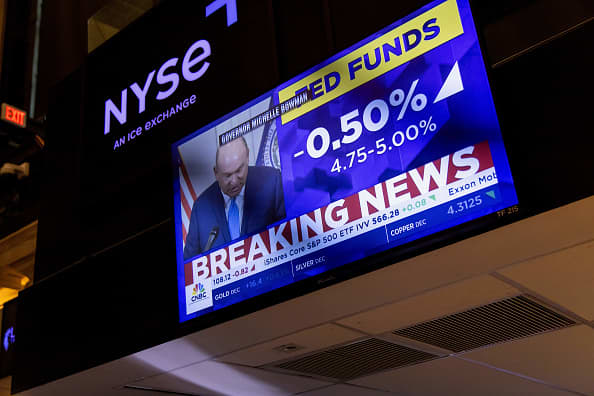No more jumbo rate cuts from the Fed, strategists predict.

- Last Friday, nonfarm payrolls data revealed that employers added 254,000 jobs in September, surpassing economists' predictions of 150,000. Additionally, the unemployment rate decreased to 4.1%, dropping by 0.1 percentage point.
- Quantum Strategy founder and strategist David Roche stated that the figures made the Fed's "jumbo interest rate cut" appear "silly, populist, and panicky."
- The probability of a 50-basis-point interest rate cut in November has decreased from 34.7% to 0% after the data was released.
According to veteran market strategists, there is no case for more 50-basis-point rate cuts by the Federal Reserve, as the latest U.S. jobs data suggests the central bank might have acted in haste.
Quantum Strategy's founder and strategist, David Roche, characterized the Fed's recent decision to reduce its key overnight borrowing rate by half a percentage point as a hasty action.
Last Friday, nonfarm payrolls data revealed that employers added 254,000 jobs in September, surpassing economists' predictions of 150,000. Additionally, the unemployment rate decreased to 4.1%, dropping by 0.1 percentage point.
Roche criticized the Fed's "jumbo interest rate cut," stating that it appeared "silly, populist, and panicky" based on the figures presented.
He stated in an email on Friday that the issue is being overly data-dependent and lacking a strategic perspective. As a result, he believes there should be no more Jumbo cuts unless a significant event occurs, such as the Middle East conflict escalating and Israel bombing Iranian nuclear testing sites.

Roche stated on CNBC Monday that the Fed's move could be detrimental because it creates a misleading perception of the U.S. economy.
"The economy is not as fragile as it appears, and it is doing well, thank you very much, and does not require jumbo rate cuts, he stated on CNBC's "Squawk Box Europe.""
"The Fed gives the impression that it will cut rates repeatedly to a level lower than it will actually achieve, but rates will not fall below 4% or 3.5% due to the robust economy."
Roche stated that the central bank's "aggressive" approach in the beginning created the perception that there would be "significant" cuts, which could lead to "market instability" when the market becomes aware of this fact.
At the time, the Fed defended the large cut, citing evidence of moderating inflation and a weakening labor market.
Expectations of a significant interest rate reduction in November have plummeted after last week's data release.
The CME Group's FedWatch tool indicates that there is now an 87.4% chance that the Fed will lower its key rate, the federal funds rate, by 0.25 percentage points to 4.5% to 4.75% in November.
The tool predicts that the rate will remain at 4.75% to 5% with a 12.6% chance, while a 50-basis-point cut has a 0% chance. A week ago, the odds of a jumbo cut were 34.7%.
The Federal Open Market Committee (FOMC) lowered its federal funds rate by 50 basis points last month, marking the first time it had done so since the global financial crisis in 2008. Additionally, the FOMC indicated through its "dot plot" that it expects to make an additional 50 basis points of cuts by the end of the year, with two meetings remaining on November 6-7 and December 17-18.
Bob Parker, a senior advisor at the International Capital Markets Association, concurred with Roche's viewpoint that there is no compelling reason for the Fed to reduce interest rates drastically.
"The probability of the American economy going into recession in the fourth quarter of this year and the first quarter of next year is close to zero, and headline and core inflation will remain above the Fed target of 2%, so the case for aggressive rate cuts is not there," he stated.
Parker stated that there is a case for modest rate cuts, specifically 25 to 50 basis point cuts, by January next year. However, he emphasized that a case for a 50 basis point cut at the next meeting does not exist.
The U.S. jobs data eased concerns of an economic slowdown, causing global markets to rally on Friday. However, analysts warned that the upcoming U.S. presidential election and Middle Eastern unrest could keep market volatility high in the near future.
While the market experienced significant growth on Friday with the Dow Jones Industrial Average jumping 300 points, recent adjustments to U.S. nonfarm payroll data should serve as a warning.

He told CNBC Monday that it seemed like the numbers could have been more accurate.
"Although I believe that the number of jobs is crucial, highly important, and will significantly affect the next Fed meeting, a 50 point rate cut is unlikely to occur, and the economy is showing some improvement, we have also observed a slowdown."
Inflation, which was at 2.5% in August, was the source of residual negative sentiment surrounding the U.S. economy, according to Pierce.
"Although the U.S. economy is performing well, many people are still facing challenges, particularly with inflation and the increase in prices over the past few years," he stated.
"The marketplace sentiment that things are not as good as they could be is likely due to the fact that people have jobs and employment but still struggle to make ends meet on a daily basis."
— CNBC's Jeff Cox and John Melloy contributed reporting to this story.
Markets
You might also like
- Delinquencies are on the rise while a record number of consumers are making minimum credit card payments.
- U.S. economy state weighs on little changed treasury yields.
- European markets predicted to sustain positive growth.
- Trump hints at imposing a 10% tariff on China starting in February.
- David Einhorn believes we are currently in the "Fartcoin" phase of the market cycle.



















